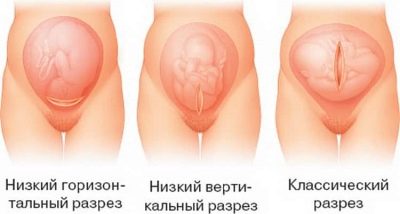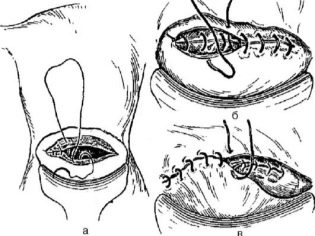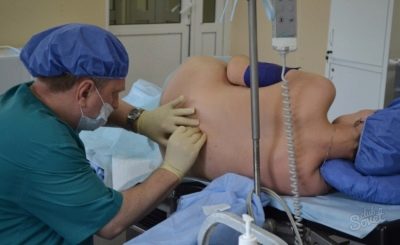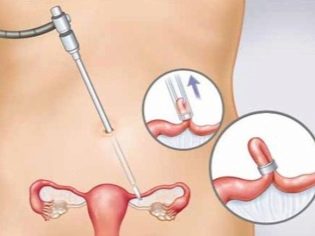How long is the cesarean section and how does the duration of the operation depend?
Caesarean section refers to the category of operations rather laborious and serious, and therefore, the operative labor lasts not for five or ten minutes. In this article, we will look at the average duration of the operation, whether it depends on the type of anesthesia, and what factors may affect the duration of the surgery.
Duration
There are several methods for performing a generic operation. And much in terms of its duration will depend on the method by which the surgeon will perform operative labor. For any of the selected methods, it takes time for the anesthesiologist to do his job: the operation cannot be started before the woman is sensitive. It takes from 10 to 20 minutes to give anesthesia, depending on the method of pain relief chosen.
Further, it all depends on the technique of surgical procedures. An incision can be made horizontally on the lower abdomen, just above the pubis. Such a cut about 10 centimeters long is called in honor of a German obstetrician, who was the first to suggest that an operative labor should be carried out just like this - according to Pfannenstiel section. Today, up to 90% of cesarean sections are performed using just this technique. The child can be removed already 20 minutes after the start of the operation.
If there is a need to make a vertical section, then the section is called corporal. The time it takes to remove a baby with this incision is significantly reduced - up to 5 minutes, but surgeons will need more time in the second stage of the operation, at which they will stitch, because the incision area is more extensive.
Any traditional operation consists of several stages:
- anesthesia;
- access to the uterine cavity;
- fetal extraction;
- the intersection of the umbilical cord;
- extraction of the placenta;
- stitching.
The average duration of the traditional cesarean section, taking into account all stages, is from 25 to 45 minutes. Much depends on the qualifications of the surgeon, the characteristics of this pregnancy, the presence or absence of complications in the process of operative labor, and preparation.
Planned and emergency operations last a different amount of time. Therefore, no one can say in advance exactly how long a specific surgical intervention will last.
Planned and emergency COP
The more thorough the doctors were able to carry out before the operation, the less the risk of complications, both in the childbirth and in the postoperative period. The document of the Ministry of Health, which regulates the procedure for preparing for a planned operation (letter No. 15-4 / 10 / 2-3190), recommends that medical teams adhere to certain rules. So, the list of preparatory measures for carrying out a planned operation is as follows:
- compulsory history taking;
- determining the condition of the child (in what position the baby is in the uterus, how much he presumably weighs, what is his heartbeat frequency) - ultrasound and CTG are performed;
- determination of the mother's condition (vaginal smear analysis, blood pressure, heart rate, skin condition);
- blood test for HIV, syphilis, hepatitis, general blood tests, coagulogram (if there is reason to assume problems with blood clotting), mandatory confirmation of blood type and Rh factor before surgery;
- consultation of the anesthesiologist (examination, identification of contraindications to certain types of anesthesia, the choice of anesthesia method).
On the day of a planned surgery, an early morning woman is given an enema to clear her intestines, and in the evening she should not eat so as not to create a load on the gastrointestinal tract and it is easier to transfer anesthesia. The night before a woman receives sleeping pills or drugs from the group of barbiturates - the so-called premedication passes.
Before you get into the operating room, a woman shave pubis. The Ministry of Health strongly recommends that all pregnant women, without exception, use compression stockings or leg bandaging with an elastic bandage to prevent thromboembolism in the early postoperative period. By the appointed time, a woman ready for surgery is delivered to the operating room, where the anesthesiologist immediately starts working.
Emergency surgery can be associated with various difficulties. First of all, they are connected with the fact that the woman is not prepared for surgical intervention.
If she ate a meal not long ago, then doctors will need to empty the stomach with a probe and water before administering anesthesia. Only then will anesthesia be administered.
Usually, in emergency delivery, delay can be a serious danger to the mother and fetus, and therefore the child will be tried to get out of the mother's womb as soon as possible, but the duration of the operation will be longer, because stitching a vertical incision (if allowed for quick removal of the fetus) will require more time. In total, the operation can last up to an hour.
In addition to the longitudinal and transverse incision, surgeons can use other methods of dissection. It all depends on the characteristics of the location of the fetus or fetuses in multiple pregnancies. Most of the following section techniques slightly lengthen the operation:
- low vertical section (corporeal, but in the lower abdomen);
- T-shaped or J-shaped cuts;
- bottom cross-section.
The doctor at his discretion chooses the method of section, given the location of the head of the baby. This is necessary in order to more carefully remove the head from the incision and not to injure the crumbs.
After incisions on the abdominal wall and the uterus, both emergency and elective surgery are performed approximately equally. The surgeon inserts four fingers below the level of the head and helps her “cut through” between the edges of the wound. The surgeon's assistant helps with pressure on the anterior abdominal wall. Alternately remove the front and rear crumbs. Then the surgeon captures the baby under the arms and retrieves it into the light.
If the birth takes place in time, the operation is planned, fetal bladder trying to open before the birth of the baby. If the birth is premature, then it is recommended to get the baby right in the fetal bladder, so the risk of infection and severe stress for him will be less. After extracting the fetus, 10 ml of oxytocin is injected intravenously into the woman, and the doctor proceeds to the separation of the placenta.
At the stage of stitching of the uterus, the reproductive organ can remain in its place, and can be brought out of the abdominal cavity. Doctors who prefer to sew the uterus in place say that its removal outside the abdominal cavity can be more painful (with epidural anesthesia). Doctors who get the uterus are sure that this reduces the duration of the surgery and reduces bleeding.
The Ministry of Health does not give clear recommendations and the question of whether to get the uterus before suturing or not is left entirely to the discretion of the surgeon. At this stage, the duration of the operation can increase the rotation of the placenta. If the “baby” place has grown into the uterine tissue, an excision of the myometrium in the area of ingrowth or the removal of the uterus will be needed, if the excision is not possible.
If the uterus is stitched with a single continuous suture, the operation time is reduced by almost 10-15 minutes.But recent studies by Canadian scientists have shown that the risk of seam divergence during a subsequent pregnancy and during childbirth (if a woman decides to give birth herself) is reduced if a more labor-intensive double row seam is applied.
Then the surgeons restore the peritoneum, if necessary, stitches on the muscle tissue and aponeurosis. To do this, use the threads that dissolve slower than the material on the uterus. Drainage has recently been rarely established, since it causes a lot of inconvenience, and there are few visible positive effects from it. The outer seam, if it is carried out with the imposition of brackets, reduces the time of the operation. Cosmetic subcutaneous continuous suture is more time-consuming, but then it looks more aesthetically pleasing.
After external suturing, the operation is considered complete. Doctors record the total time of surgery.
Epidural and General Anesthesia
Spinal anesthesia is recommended by the method of first choice. In spinal anesthesia, preparations with a long and very fine game are introduced into the subarachnoid space of the spine, they wash not only the nerve roots, but also the spinal cord, as a result of which a fairly quick and stable analgesic effect can be achieved. The numbness of the lower body of the woman after the puncture begins to experience within 5-7 minutes, and doctors can begin the operation.
If for some reason spinal anesthesia is contraindicated to the woman or the woman herself refused it, general anesthesia is administered. It requires a little more time than spinal. First, a woman will be given an intravenous anesthetic injection. After she falls asleep, a tracheal tube will be inserted into the trachea and connected to the ventilator.
This process is more labor-intensive, it depends on the skill of the anesthesiologist and the patient's vital signs - her pressure, pulse. If there are no complications at this stage, surgeons can begin the operation approximately 10 minutes after the anesthesiologist starts working.
Epidural anesthesia involves the introduction of drugs in the same (epidural) space of the spinal column. The time required to achieve an analgesic effect is higher than with other types of anesthesia - up to 25 minutes. Emergency caesarean section is performed under general anesthesia, with a planned operation there are options.
Stark section
Today, a caesarean section, proposed more than 20 years ago by the Israeli doctor Michael Stark, is becoming popular in a number of perinatal centers. Such an operation differs from the classical one with less trauma and less time for performing surgical procedures. The doctor makes only two cuts - on the skin of the peritoneum and on the uterus, he spreads his hands, moves them away, and then returns them to the proper place. There is no need to suture muscle tissue separately.
The Stark operation lasts no more than 20 minutes. This reduces the harm to the mother and fetus due to the action of anesthetics, drugs used for pain relief. The risks of bleeding after Stark section are lower, since there are no unnecessary cuts and cuts. The rehabilitation period after such an operation is also easier and shorter, the woman gets up faster.
An operation that goes less in time, alas, can not be done to everyone. There is a list of contraindications, which include fibroids, nodes, large veins in the area of separation. In this case, the doctor will stop manual dilution and will carry out operative labor with the classical method. Disputes about the Stark section in a professional medical environment do not subside, the method has its admirers and opponents.
Repeated operation
Does the duration of the operation change with repeated cesarean section? The answer is obvious: the operation lasts a little longer (in the absence of complications - for 5-7 minutes).This time is necessary for the surgical team at the second caesarean in order to excise the old scar, which remained after the first surgical delivery and form a new one. The second scar, therefore, does not appear on the woman’s stomach, nor does the additional second scar appear on the uterus - the operation is performed along the old scar.
There are exceptions when the situation requires laying a cut along a new trajectory. But such situations are more rare than the rule.
What affects the duration?
Thus, the duration of a cesarean section depends on a variety of factors. It may be shorter if the doctor is well prepared, the woman is pre-examined and the surgery is performed as planned. The following factors may make operative delivery more lasting:
- any complications during the operation (injury to the internal organs, ureters and intestines, bladder, dissection of large vessels, bleeding);
- the number of fetuses (operation in single-parent pregnancy is done faster than during pregnancy with twins);
- pathology in a child or in children, for example, in the case of accrete twins, they only operate vertically, which increases the duration of the intervention;
- the complexion of the woman (in puerperal women with obesity, more time is spent on suturing the subcutaneous tissue);
- the need for advanced surgery (in addition to caesarean, you need to hold the waist of the pipe, removal of fibroids, tumors in the uterus, as well as the need to restore the injured bladder or intestines, if this happened);
- the need for additional measures (for example, blood transfusion of the puerperal).
Women reviews
Exact information about the duration of the delivery operation from the thematic forums on the Internet, where women leave their feedback, is quite difficult to gather. The reason lies in the fact that women usually do not track how much time has passed, even if the entire operation is conscious (with spinal or epidural anesthesia). The perception of time is changing, and this is quite natural, because a woman is under severe stress. With general anesthesia, a woman, in general, is not able to monitor anything, because she is in a state of deep sleep.
According to reviews of puerperas, cesarean lasted on average for about 30-40 minutes. Some are confident that they had been in the operating room for about an hour.
What is this operation and how it affects the health of the mother and child, see below.





























